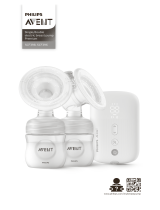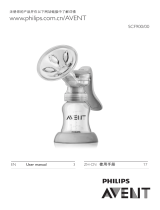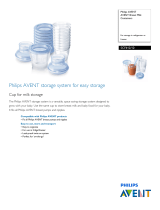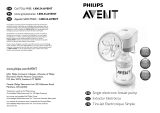
6
GB
Please remember that, should the process become very painful or
uncomfortable, you should stop using the pump and consult your
health professional or breastfeeding advisor.
9)
Whilst some women may prefer to use the pump without the Let-down
Massage Cushion, extensive trials show that, in most cases, the massaging
effect of the petals flexing in and out around the areola stimulates the
let-down reflex and allows you to express more milk, faster.
10) On average you will need to pump for 10 minutes to express 60-
125ml or 2-4oz. However, this is just a guide and varies from woman to
woman. If you find that you regularly express more than 125ml per
session, please use a 260ml/9oz AVENT Bottle or 240ml/8oz VIA Cup.
Do not overfill AVENT Feeding Bottles or VIA Cups and keep upright,
otherwise milk may leak from below the pump body.
10. Storing your breast milk
• Breastmilkcanbestoredin
the fridge or freezer in either
sterile breast milk containers
(125ml/4oz or 260ml/9oz
bottles fitted with sealing discs)
or in VIA Cups with lids.
• Onlymilkcollectedwithasterile
pump should be stored to be fed to your baby.
• Expressedmilkshouldberefrigeratedimmediately.
• Expressedbreastmilkcanbestoredintherefrigeratorforupto
48 hours (not in the door) or in the freezer for up to 3 months.
• Ifyouarestoringmilkinthefridgetoaddtoduringtheday,onlyadd
milk which has been expressed into a sterile container. Milk can only
be kept like this for a maximum of 48 hours (from first expression)
after which it must be used immediately or frozen for future use.
• Forproductsotherthanbreastmilkmakefeedsupfreshwhen
needed, following the manufacturer’s instructions.
Storing your milk in the fridge
If your expressed breast milk will be fed to your baby within 48 hours,
it can be stored in the fridge (not in the door) in an assembled AVENT
7
GB
Feeding Bottle or VIA Feeding System. Assemble a sterilised teat,
screw ring and dome cap and attach onto the body of the AVENT
Bottle or the VIA Adaptor and Cup (see below).
Storing your milk in the freezer
To store in the freezer, use a sealing disc in place of the teat and
dome cap or use a sterilised VIA Lid to seal the VIA Cup. The storage
containers should be clearly labelled with the date and time of
expression and older milk used up first.
NEVER refreeze breast milk. DO NOT add fresh breast milk to already
frozen milk. ALWAYS discard any milk that is left over at the end of a feed.
11. Feeding your baby your expressed breast milk
If breast milk has been stored in an AVENT Breast Milk
Container, replace the sealing disc with a sterilised
AVENT Teat.
Alternatively replace the VIA Lid with a sterilised VIA
Adaptor, screw ring, dome cap and AVENT Teat.
Frozen breast milk should be defrosted overnight in the
refrigerator. However, in an emergency, it can be defrosted
in a jug of hot water. Once thawed use within 24 hours.
Breast milk can be heated in the same way as any other bottle feed.
Stand the AVENT Bottle or VIA Feeding System in a bowl of hot water,
or alternatively, for a safe and fast way to warm feeds, use the Philips
AVENT Bottle and Baby Food Warmer. IMPORTANT! Milk or food will
heat faster in VIA Cups than in standard feeding bottles/containers.
Always check milk or food temperature before feeding.
Never heat milk in a microwave as this may destroy valuable nutrients
and antibodies. In addition, the uneven heating may cause hot spots
in the liquid which could cause burns to the throat.
Never immerse a frozen milk container or VIA Cup in boiling water as
this may cause it to crack/split.
Never put boiling water directly into a VIA Cup, allow to cool for
around 20 minutes before filling.














